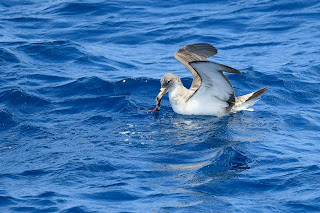The "Talk"
Swell from the southeast and wind from the southwest is what we had for this Friday and Saturday set. Friday winds were light...but there were a lot of birds sitting around out there, especially Black-capped Petrels! One flock even had a Band-rumped Storm-Petrel sitting with them! Though as you can see, these birds tend to flush well ahead of the boat when we see them on days with lighter winds.
Saturday we had a bit more wind and this was superb because the birds were really moving and we could practice identification at a distance for Great and Cory's Shearwaters then see how differently they moved next to the Black-cappeds! (Photos Black-capped top, Great Shearwater bottom)
It was a great set of trips for those who joined both with a South Polar Skua showing well (though not close) at the end of the trip on Friday then a couple of Sooty Terns, our first for the year, Saturday morning as we came along a nice Sargassum line. Otherwise we had the usual suspects with a few gems like a quick Leach's Storm-Petrel on Friday and a Band-rumped Storm-Petrel sitting patiently on the water for us to approach on Saturday.
There were more Cory's and Cory's type Shearwaters around on Friday then a lot of Great Shearwaters on the move Saturday!! Numbers of Sargasso Shearwaters were about the same on both trips though we really got to see them soaring on Saturday 😉. This spring has been a bit bizarre in a few ways...not as many Wilson's Storm-Petrels as we usually see and hardly any of the winter breeding "Grant's" type Band-rumped Storm-Petrels. Zero Desertas Petrels this spring and not many Cory's or Scopoli's. Really interesting, and though there have been years with similar numbers in the past, we were not closely tracking the Grant's or Cory's / Scopoli's. Wilson's did not have a strong showing this weekend either with just 39 on Friday and 21 on Saturday.
We have encountered a number of billfish this spring, however, and this weekend was no exception with at least two Blue Marlin seen on Friday's trip here is a record shot of one!
Brian and I were super excited to welcome back our friend Hadoram Shirihai who is now living in Portugal with his wife, Reut, and daughter Teva. He has spent more time at sea than most humans and is a wealth of information about seabirds and other marine species. His Tubenose Project is hopefully coming out soon and the first volume will cover Pterodroma petrels. We are all waiting to see this masterpiece that will include our Black-capped Petrel and all of the variation we observe here! He agrees that it is likely these birds could represent more than one species that have been restricted by human activity and pushed into smaller and smaller suitable nesting locations resulting in the variation we see now. Hopefully more genetic work will soon give us a better handle on what is going on with these amazing and resilient birds!
Kate, Hadoram, and Brian on the bow of the Stormy Petrel II
Thank you so much to everyone who joined us on this set and a huge thank you to Ed Corey for helping Brian Patteson, Daniel Irons, and me (Kate Sutherland) lead the trips! All of the photos today are mine.
eBird Trip Reports can be found here:
Species List for 13 / 14 June 2025
South Polar Skua 1 / 0
Sooty Tern 3 / 0
Black Tern 15 / 8
Common Tern 1 / 0
Royal Tern 3 / 2
Wilson's Storm-Petrel 39 / 23
Leach's Storm-Petrel 1 / 0
Band-rumped Storm-Petrel 4 / 8
Black-capped Petrel 110 / 35
Atlantic Cory's Shearwater 12 / 8
Scopoli's Shearwater 2 / 2
Cory's / Scopoli's 22 / 25
Great Shearwater 37 / 82
Sargasso Shearwater 49 / 33
Atlantic Spotted Dolphin 0 / 11 to 12
Blue Marlin 2 / 0
Billfish species (white or sail) 1 / 0
Mahi mahi (Atlantic Dolphinfish) caught 1 / 0
One of our first Sooty Terns of the year!
The South Polar Skua - yes - just a record shot! We saw it well but it didn't come super close for us...
Most of the Black-cappeds we saw were intermediate looking but there were a handful of dark form birds like this one
Cory's Shearwater
Scopoli's Shearwater
A few Great Shearwater images! They are so wonderful to have around the boat and are totally fearless (maybe not the best trait here offshore from Hatteras...).
A Sargasso (previously known as Audubon's) Shearwater
Record shot of one of our Band-rumped Storm-Petrels
Common Tern in the slick on Friday
Some environment images from our Saturday trip!
And the cloudscape on Friday!



























































